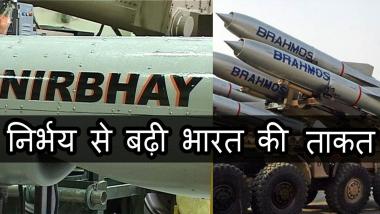
India on Nov 7, 2017 successfully flight-tested its indigenous Nirbhay (the fearless) land-attack cruise missile, which can deliver nuclear warheads to a strike range of 1,000-km, after a string of failures since March 2013.
The development is significant because the armed forces have long been demanding nuclear land-attack cruise missiles (LACMs), with ranges over 1,000-km and versatile enough to be fired from land, air and sea.
Often brandished as India's answer to the famed American Tomahawk missiles, as also an effective counter to Pakistan's Babur LACM, the Nirbhay had been in the making for a decade without much success till now.
The sub-sonic missile, designed to carry a 300-kg nuclear warhead, had failed during its first test in March 2013.
Though the second test in October 2014 was a partial success, the third and fourth tests in October 2015 and December 2016 also flopped, leading to talk that the project may have to be scrapped.
The missile has the capability to loiter and cruise at 0.7 Mach, at altitudes as low as 100 m.
The flight test achieved all the mission objectives completely from lift-off till the final splash, boosting the confidence of all scientists associated with the trial.
The guidance, control and navigation system of the missile is configured around the indigenously designed Ring Laser Gyroscope (RLG) and MEMS based Inertial Navigation System (INS) along with GPS system.
The missile majestically cruised for a total time duration of 50 minutes, achieving the range of 647 km.
The fifth test from the Integrated Test Range at Chandipur off Odisha coast, was dubbed a "complete success" by DRDO.
A series of successful tests of this ground-launched version of Nirbhay will pave the way for its induction into the armed forces, though its sea-based variant capable of being fired from nuclear-powered submarines will be the real game-changer.
Difference Between Ballistic and Cruise Missiles- Ballistic missiles like the Agni follow a parabolic trajectory, leaving and re-entering the earth's atmosphere before hitting their targets.
- Cruise missiles like Nirbhay, in turn, are designed to fly at low-altitudes, almost hugging the terrain, to evade enemy radars and missile defence systems.
- Nirbhay has the capability to loiter and cruise at Mach 0.7 at altitudes as low as 100-metre.
- After an initial blast off with a solid-propellant booster rocket engine to gain speed and altitude, Nirbhay deploys its smallish wings and tail fins in the second-stage to thereafter fly like an unmanned aircraft.
- It's designed to be highly manoeuvrable with "loitering capabilities" to first identify and then hit the intended target with precision.
BrahMos: Know More - The supersonic BrahMos missiles, produced jointly with Russia, have already been inducted into the armed forces.
- But the BrahMos, which flies almost three times the speed of sound at Mach 2.8, is meant to carry only conventional warheads and currently has a strike range of only 290-km.
- At least three tests of the extended range (450-km) BrahMos have been conducted after India joined the 34-nation Missile Technology Control Regime (MTCR) in June 2016.
- India, of course, has come a long way in developing nuclear-capable ballistic missiles like the Agni series, which have strike ranges from 700-km to over 5,000-km.